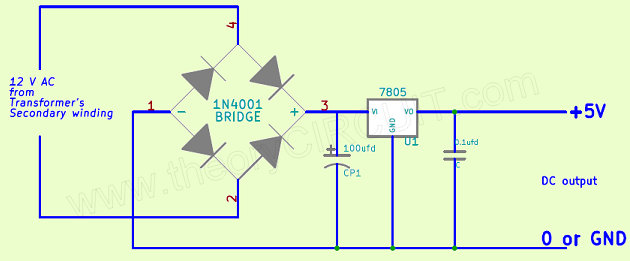Last Updated on March 16, 2024
We need DC Regulated Power supply for Most electronic components to function properly, 5V DC supply is the required bias for most electronic components and Logic circuits, Here is the procedure to designing a robust 5V regulated power supply circuit by using few easily available components. This AC to DC 5V Regulated Power supply circuit can provide constant DC supply without any AC ripples.
Circuit Diagram
This circuit is most commonly used in 5Volt DC Regulator, Here IC7805 is used as a reulator due to its regulating characteristics this circuit provides constant 5 Volt DC output. Bridge rectifier consists of four 1N4001 diode and then 100uF capacitor filters large size ac ripples.
Un regulated DC voltage range from 8 volt to 12 volt is applied to the IC7805 regulator. In this IC pin 1 is considered as input and pin 2 falls on ground then pin 3 gives regulated output. At the ouput pin 0.1 uF capacitor is connected for to remove small sized ac ripples from regulated DC output. Finally at the ouput you will get regulated 5 Volt DC.
Components List
| S.No | Name | Quantity |
| 1. | Diode 1N4001 | 4 |
| 2. | Capacitor 100uF & 0.1uF | each 1 |
| 3. | IC 7805 | 1 |

I am using zener regulator component. 🙂
thanks for your interest 🙂
the regulator IC7805 gives more reliable output than zener breakdown regulator component.
Should i ground transforner’s secondary winding terminal with 7805 and both capacitors?
Hi Tirth
If you are using normal transformer (two wire Secondary) means there is no need, connect those two terminals with bridge rectifier.
In case you are using center tapped transformer (example: 6-0-6 three wire secondary) means you can use any one side (6-0 or 0-6) to the bridge rectifier. in these above statements there is no need to ground transformer’s secondary winding terminals with components.
would it make a difference if i use 1N4007 insted of 1N4001
This is great but what specific transformer is used? Try searching for “5v power transformer” and you will get everything from ac-dc converters to step-up and step-down modules. Where does one find the transformer needed for this circuit?